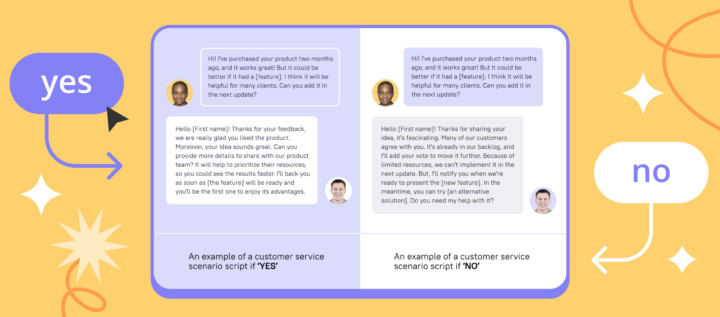Best Dashly Articles of 2020

This year was challenging and productive at the same time. In Dashly, we’ve written over 100 articles. Some of them became very popular, so we decided to collect them all in a digest. I know you want to read them all, but there is a lot of time needed.
So we decided to collect the most popular of them in a digest. Choose and read the most interesting theme for you?
Guide on chatbots
The future is now. This phrase accurately describes chatbot’s development.
Chatbot platform may relieve your support and marketing teams already now. They send messages to users, communicate with them, lead to a purchase, and provide customer assistance. Chatbots may relieve your support and marketing already now. These automated assistants will save time, which your team can spend on more complicated tasks.
But the sky’s the only limit. Chatbot development is always continuing so there are several trends of what we can expect from them in the near future.
We’ve collected everything you want to know about chatbots in one article. Here you’ll find what chatbots are, how they can help grow your business depending on their type, and key trends for 2022.

Product marketing kit
Who the hell is a product marketer? Literally, this is a person who delivers a product to a market. Product marketing is a combination of sales, support, marketing, and of course, product. PMs are in charge of positioning, messaging, and customer development before the release and are responsible for driving demand for the product to the audience.
In case you still have a dim view of who is a product marketer, help is on the way. Read our article with an ultimate description of what a PM’s job includes.

Growth hacking
Growth hacking is a data-driven methodology that uses traditional marketing techniques for testing new hypotheses of product growth. As you’re here, I guess you already know this. No? Time to fix that!? Especially for you, we’ve prepared two articles on what growth hacking is and why this is worth your attention.
In the first part, you’ll find a growth hacking definition, how to test hypotheses, and why you need to test over 300 of them per year.
We’ve also prepared tools to use when ensuring growth and insights on hypothesis generation from Growth Hacking Evangelist. You can read this in the second part.

Read also:
👉 How to use lead generation chatbot for your website
👉Lead nurturing platform for your revenue growth
👉 12 types of marketing nurture campaigns
Jobs to be done
Are you sure your users understand you the way you meant it to be? Do you know why they buy your product? What problem do they solve with you? What influences their purchase decision?
These are questions that the JTBD framework covers. This also helps to define unobvious competitors and the way you can outdo them.
In the first part of our article about JTBD, you will find a theoretical basis about Jobs To Be Done: definition, interpretations, and how this can help your business. In the second part, we’ll go deeper into practice: you’ll learn how to implement JTBD, how to formulate job stories, conduct interviews that will be valuable for your research, and how to analyze data.
You can also use the JTBD theory to create your buyer persona portrait. Recently, we did so. Read our story full of insights.

How to set goals properly?
When Dashly grew from 10 to 30 people in the team, we became defocused and asynchronous. At that moment we decided to try OKR to fix that.
What exactly are OKRs? This is a goal-setting framework that helps companies to determine the main direction for growth. This framework’s main advantage is that teams are getting synced up and involved in goal setting. Therefore, people become more interested in implementing these goals.
It was a valuable experience, so we decided to write a series of articles dedicated to OKRs. In the first part, you’ll learn basic notions from the OKR framework: what are objectives, key results, and initiatives, how to formulate them.
The second part is a step-by-step guide on implementing OKRs to your company, including our experience and mistakes to avoid. Also, you may read an interview with an ORK expert if you still have some questions left.

Read also:
- 10 best customer engagement strategies
- Client onboarding: how to engage, retain, and win users
- Customer engagement strategy: a complete guide to winning prospects in 2023
- What customer engagement platform is best for your business? 15 options to choose.
Useful metrics to measure
There are many business metrics, so it became easy to get confused. Some of them help you to understand whether you grow or not; others evaluate your success in some distribution channels, and so on.
We also had such a problem. There was an abundance of metrics, and it was difficult to understand which of them can help us evaluate results.
To work on this problem we’ve read tons of info and accumulated the most important. But it would be unfair not to share this with you, right?
In these four articles, you’ll find tips about the most crucial business metrics: how to use them, why you need to calculate them and understand its benchmarks:

Read also:
- 10 best customer engagement strategies
- Client onboarding: how to engage, retain, and win users
- Customer engagement strategy: a complete guide to winning prospects in 2023
- What customer engagement platform is best for your business? 15 options to choose.
Guide on researches + Dashly insights
The year of 2020 in Dashly may be called “A year of research.” We’ve conducted lots of ones and proved their effectiveness for us. Research helps to verify hypotheses so that, eventually, you will spend less time and money you would otherwise waste implementing useless features.
We asked our friends from product-first companies to share their research experience: how do they conduct research, how to filter insights, what tools do they use, etc. You can read it here.
We’ve also prepared an article on how to search for interview respondents. Find the main tips in the article.
There is another way to check some hypotheses that require fewer resources — the hallway usability testing. The main thing about hallway testing is that you can literally catch people in the hallway and conduct the test with them. All you need is a prototype and 10 minutes of your time. Learn how to run great hallway usability testing, what questions to ask, how to make conclusions based on them, and so on here.

Maximizing the conversion rate
How does the funnel look like? A big hole at the top and a small hole at the bottom. How to make more users reach the bottom of the funnel? Get rid of bottleneck, i.e., funnel stages where many users leave.
For example, your funnel looks like this: you collect leads from your landing page, then you send them emails, and lead them to sign up. But people don’t want to convert into clients after reading your email distribution. What should you do then?
Here are 12 tips for maximizing your email conversion rate prepared by our email marketer Polly. This article will help to optimize your email marketing effort and increase the conversion rate.
Read more
- 10 Best Live Chat Software for Customer Support
- 10 Best Customer Service Chatbot Platforms to Level Up the Work
- How to create a user journey online map for your online school students [4 free templates]
- Increase Customer Support Efficiency With 15 Best Knowledge Base Tools
- Chatbot Guide: What can a chatbot do for your customers 24/7




![10-step Guide on How to Create a Chatbot for your Website [Build without code]](https://www.dashly.io/blog/wp-content/uploads/2022/06/How-to-create-a-chatbot-to-automate-conversations-with-your-website-visitors-720x317.png)


![21 proven tools for your 2025 marketing tech stack [Recommended by market experts]](https://www.dashly.io/blog/wp-content/uploads/2022/08/martech-stack-999-720x317.png)